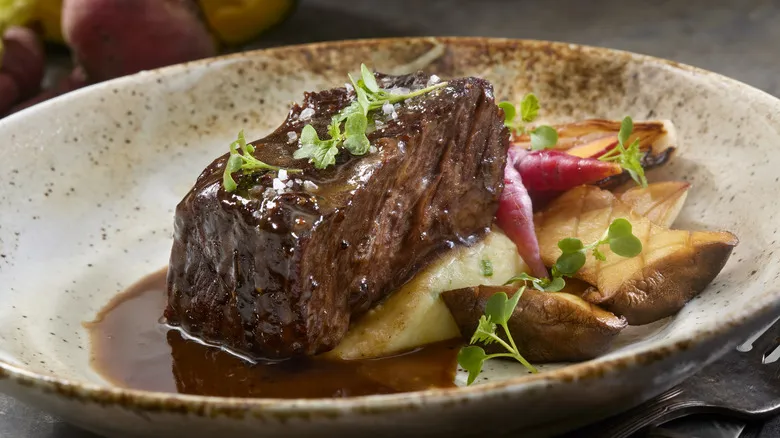Use the oil as a dressing

With a splash of canned tuna oil, you can quickly create a tasty dressing that's ideal for salads, pastas, and more. While you can use any cooking oil to make a simple dressing, opting for tuna packed in olive oil will yield the best flavor. Many dressing recipes call for olive oil as a base, so you can easily substitute in the tuna oil and adjust the quantities as needed. For a super quick dressing, combine the tuna oil, lemon juice, and a pinch of salt and pepper in a resealable container. Aim for less juice than oil; some dressings follow a 1-to-3 ratio, but for this fish-infused oil, a more acidic 2-to-3 ratio works well. For instance, if you have three-quarters of a cup of oil, balance it with half a cup of lemon juice. To emulsify the dressing, seal the container and shake it vigorously until everything is well mixed.
The fishy flavor of the oil will impart a delightful hint of aquatic umami to any salad you drizzle it on, and it pairs especially well with tuna. Incorporating this homemade dressing into a pasta dish enhanced with canned tuna is an affordable and easy way to maximize the flavor of your canned fish. If you make the tuna oil dressing, be sure to store it in the refrigerator and use it within four days for the best freshness.
Fry up your favorite foods

One of the simplest ways to utilize excess tuna oil is by using it as a regular cooking oil for frying a variety of foods, from eggs to onions. While olive oil is likely your best option, as it not only adds a delightful fish flavor but is also one of the healthiest cooking fats available due to its high antioxidant content. You can opt for other oils, but be mindful of their smoke points to avoid burning your food (soybean and canola oils are similar to olive oil, while sunflower oil should be used with caution). To use tuna oil for frying, simply collect it as you drain the fish until you have enough to cook your desired dish. The possibilities are truly endless.
Eggs are a popular choice for frying and pair wonderfully with the tuna flavor of the oil. For a dish rich in savory fish taste, try frying a couple of eggs in the tuna oil as you normally would. Then, serve them over a salad mixed with canned tuna and drizzled with your homemade tuna oil dressing!
Turn the oil into a sophisticated dip

Since the oil used to pack tuna is rich in flavor, you can easily turn it into a sophisticated dip that's ideal for gatherings or as a starter. Simply reserve enough oil to fill a shallow dish or bowl, then sprinkle on your choice of herbs and spices. You can keep it straightforward with just a touch of salt and pepper, add an Italian flair with garlic and oregano, or embrace a Mediterranean essence with dill and rosemary.
This dip pairs wonderfully with soft, absorbent breads like naan or focaccia, as well as crusty options like baguettes. To elevate the experience, serve it with baguette slices that have been toasted in the tuna oil. You can also enjoy it with fresh vegetables like carrots and celery, or use the infused oil to add a glossy touch to pizza, flatbread, or any dish that could benefit from an extra burst of flavor.
Upgrade soups and sauces

Tuna oil is an excellent ingredient for enhancing the richness and complexity of nearly any dish, particularly a variety of soups and sauces. Essentially, whenever a recipe calls for olive oil, you can substitute it with the oil found in a can of tuna to instantly infuse a burst of umami flavor and a touch of added nutrition. For instance, using tuna oil can elevate a classic garlic aioli by incorporating the zesty brightness of lemon, as the fish complements both flavors beautifully. It also serves as a fantastic base for puttanesca sauce, which typically features anchovies and can easily be adapted with canned tuna.
Whether incorporated during cooking or drizzled on afterward, a splash of tuna oil can significantly enhance a bowl of soup, provided it’s paired with harmonious flavors. It can gracefully balance and soften acidic notes like citrus while enriching hearty stews made with ingredients such as beans or chickpeas. Give roasted butternut squash soup a drizzle of tuna oil and see if you can notice the difference!
Saute or sear fish and veggies

When sautéing or searing ingredients, the high heat from a flat-bottomed pan cooks the food effectively, requiring only a small amount of oil to prevent sticking. This makes the teaspoon or so of oil found in an average can of tuna ideal for enhancing any seafood dish with a flavorful tuna infusion.
This technique is particularly effective for cooking fish, especially fillets with the skin on. The rich tuna oil serves as an excellent medium between the hot pan and the crispy fish skin, leading to a remarkable final dish. Pair it with a ramekin of saffron-infused rouille (a variation of mayonnaise) made with the tuna oil, along with sautéed diced peppers and onions cooked in the same flavorful oil, and you have a delightful seafood feast.
Cooking at home often involves maximizing what you have on hand. So, as you explore ways to elevate canned tuna, remember to enhance the oil as well.
Recommended

The Hassle-Free Trick To Easily Refill Your Pepper Mill

Ree Drummond's Plastic Bag Hack For Effortlessly Moist Omelets

Chuck Flap: The Rich Beef Cut You Need To Try Slow-Cooking

11 Ways To Upgrade Corned Beef
Next up

